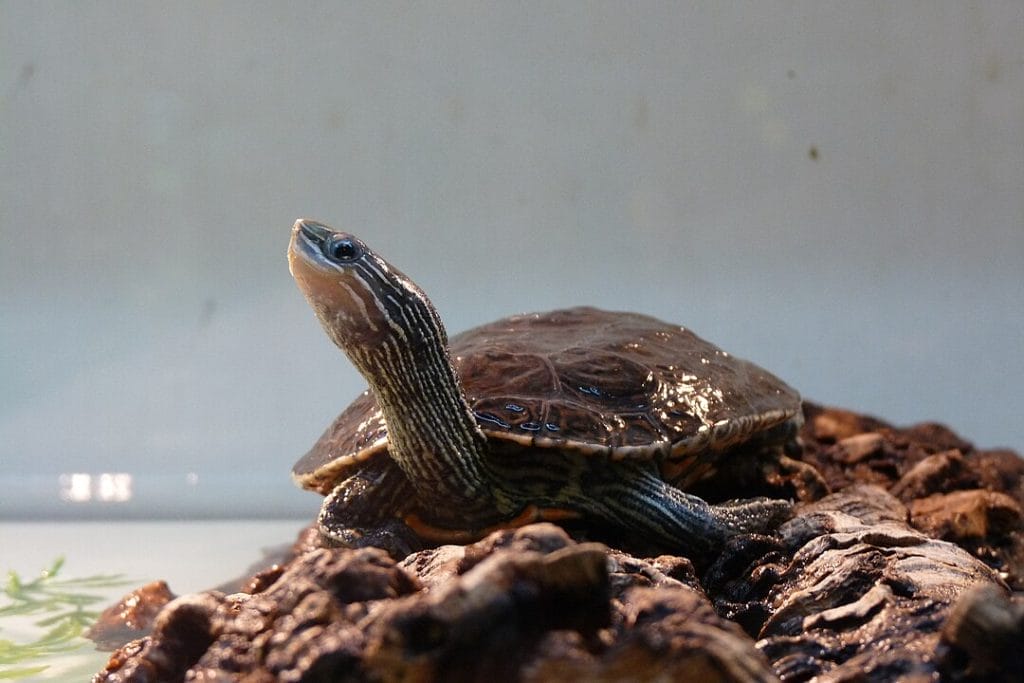Mauremys rivulata (Balkan pond turtle)
Home > Turtle Database > Mauremys rivulata (Balkan pond turtle)

Mauremys rivulata, commonly known as the Balkan pond turtle, is a freshwater turtle species native to the Balkan Peninsula. Known for its distinctive shell patterns and adaptability, this turtle plays a vital role in its ecosystem. Despite facing various threats, conservation efforts are underway to ensure its survival.
Native To These Regions
Albania, Bosnia and Herzegovina, Bulgaria, Croatia, Greece, Israel, Jordan, Lebanon, Montenegro, North Macedonia, Serbia, Slovenia, Syria, TurkeyNative Turtle Species Map – Find Turtles by Region
Scientific Classification
- Kingdom: Animalia
- Phylum: Chordata
- Class: Reptilia
- Order: Testudines
- Family: Geoemydidae
- Genus: Mauremys
- Species: Mauremys rivulata
Common Names
- Balkan pond turtle
- Rivulated pond turtle
- Balkan terrapin
This Hilarious Turtle Book Might Know Your Pet Better Than You Do
Let’s be real—most turtle care guides feel like reading a textbook written by a sleep-deprived zookeeper.
This one’s not that.
Told from the snarky point of view of a grumpy, judgmental turtle, 21 Turtle Truths You’ll Never Read in a Care Guide is packed with sarcasm, sass, and surprisingly useful insights.
And hey—you don’t have to commit to the whole thing just yet.
Grab 2 free truths from the ebook and get a taste of what your turtle really thinks about your setup, your food choices, and that weird plastic palm tree.
It’s funny, it’s honest, and if you’ve ever owned a turtle who glares at you like you’re the problem—you’ll feel seen.
Identification
Description
The Balkan pond turtle has a moderately domed shell typically ranging from 15 to 20 centimeters in length. Its carapace is adorned with distinct ridges and a pattern of radiating lines, which provide camouflage among aquatic vegetation. The plastron is usually yellowish with dark markings, and the limbs are strong with webbed feet adapted for swimming.
Sexual Dimorphism
Males can be distinguished from females by their longer, thicker tails and more concave plastrons. Additionally, males often exhibit brighter coloration on their heads and necks compared to the generally more subdued hues of females.
Check more turtles from the Mauremys genus
Native Origin and Distribution
Geographical Range
Mauremys rivulata is primarily found in the Balkan Peninsula, including countries such as Greece, Albania, North Macedonia, and parts of Bulgaria and Serbia. Its range extends to various freshwater habitats within these regions.
Preferred Habitat
This turtle species thrives in slow-moving or stagnant freshwater environments like ponds, marshes, and small lakes. They prefer areas with abundant aquatic vegetation, which provides both food sources and shelter from predators. Sandy or muddy bottoms are typical, allowing them to easily forage and bask.
Behavior
Feeding Habits
Balkan pond turtles are omnivorous, feeding on a diet that includes aquatic plants, insects, crustaceans, and small fish. They forage both underwater and on land, using their strong jaws to crush hard-shelled prey and nibble on vegetation.
Predators
Natural predators of Mauremys rivulata include birds of prey, larger fish, and mammals such as raccoons and foxes. Juvenile turtles are particularly vulnerable to predation until they reach a more substantial size.
Reproduction
Breeding Season
The breeding season typically occurs in the spring and early summer when temperatures rise and food availability increases. During this period, males engage in courtship behaviors to attract females.
Reproductive Method
Females lay clutches of 5 to 15 eggs in sandy or soft soil near water bodies. The incubation period lasts several weeks, with temperature influencing the sex of the hatchlings. Once hatched, the young turtles make their way to the water to begin their aquatic life.
Conservation
Extinction Status
Mauremys rivulata is currently classified as Least Concern by the IUCN Red List. However, certain local populations may be at risk due to habitat degradation and other threats.
Threats
Primary threats include habitat destruction due to agricultural expansion, urbanization, and pollution. Additionally, illegal collection for the pet trade and use in traditional medicine poses significant risks to wild populations.
Conservation Measures
Conservation efforts focus on habitat protection and restoration, enforcing regulations against illegal trade, and promoting public awareness about the species. Establishing protected areas and breeding programs in captivity are also strategies being employed to safeguard this turtle.
Economic Importance
While not a major economic species, Mauremys rivulata contributes to local economies through ecotourism and as part of the pet trade. Additionally, turtles play a role in controlling aquatic vegetation and maintaining healthy freshwater ecosystems, indirectly supporting fisheries and agriculture.
Interesting Facts
- Balkan pond turtles can live up to 40 years in the wild, showcasing remarkable longevity for reptiles.
- They exhibit temperature-dependent sex determination, where the incubation temperature of eggs influences the gender of the offspring.
- This species is known for its ability to aestivate during dry periods, allowing it to survive in fluctuating environmental conditions.
- Mauremys rivulata has been observed engaging in communal basking, where multiple individuals gather to regulate their body temperature.

About Author
Muntaseer Rahman started keeping pet turtles back in 2013. He also owns the largest Turtle & Tortoise Facebook community in Bangladesh. These days he is mostly active on Facebook.














